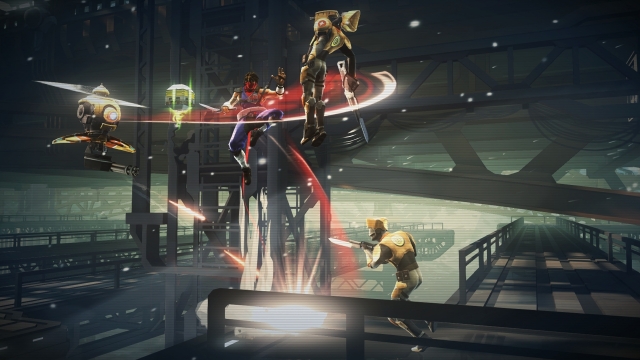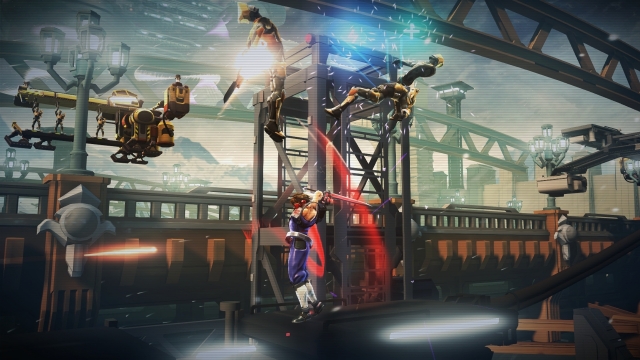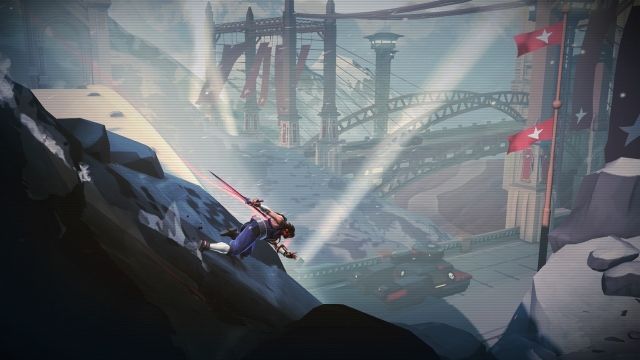
Strider Review
For a company like Capcom, creators of so many iconic, memorable and bankable characters over the years, it's easy for them to neglect some in favour of others. What's surprising is how a character like Strider Hiryu almost seemingly got lost in the annals of gaming history, destined to peek his head out in Capcom crossovers only to pad out the roster numbers. Strider oozes style and excitement in both game and character, and resurrecting the franchise had the difficult task of appeasing the fans of the original 1989 classic, and introducing this ageing badass to new audiences.
Swooping down to Kazakh City on his hawk glider, Strider Hiryu is thrown straight into the action, slicing and dicing opponents, sprinting, jumping and climbing his way to the next checkpoint. There is a specific energy from the outset that never seems to wane from the first couple of hours with Strider, and the pace doesn't let up until past the first couple of bosses.
Those looking for a story to sink their teeth into should probably look elsewhere. Despite the futuristic, Eastern setting, and with this being essentially a reimagining of the original 1989 story, a lot of the narrative has to be assumed, with small snippets of dialogue interchanges containing little information occurring every now and then. Towards the end of the game, you're not really any more the wiser as to why you're killing people in their hundreds than at the start of the game. An experience like Strider doesn't necessarily require a deep, intertwining narrative, but no effort has been given beyond 'This is Grandmaster Meio. He's bad. Go get him.'
 The main meat of Strider fortunately makes up for this oversight, as the controls, while not 100% perfect, are simple and responsive. Climbing is simply a case of pushing towards a wall, then moving up and down. You cling to ceilings easily, you jump over enemies with little effort and hammer the action button until they fall. Nothing is too taxing, and with Strider's style and ease of control you look amazing while you pull off incredible combos, combos that other games would require thumb-breaking inputs to pull off.
The main meat of Strider fortunately makes up for this oversight, as the controls, while not 100% perfect, are simple and responsive. Climbing is simply a case of pushing towards a wall, then moving up and down. You cling to ceilings easily, you jump over enemies with little effort and hammer the action button until they fall. Nothing is too taxing, and with Strider's style and ease of control you look amazing while you pull off incredible combos, combos that other games would require thumb-breaking inputs to pull off.
Strider is a hugely accessible game, and while its base gaming is fairly simple to learn, the numerous, frequent boss battles provide an arena to properly test your mettle. Usually epic in scale (the arduous trek along a mechanical dragon's body mid-flight remains from the original), some fights really put your skills of jumping, attacking, timing and precision to the test, especially when you have to fight The Winds, three bosses (two of whom you've already defeated) simultaneously.
Whilst trying my best not to mention the term 'Metroidvania', there really is no other term that fits Strider's description as well as this. Capcom have borrowed the best elements of both games in this portmanteau, given it a dash of Shadow Complex, and have tacked Strider's mug on the front. There is a simultaneous lack of originality and sense of playing something unique throughout Strider. It borrows, adapts and innovates on the exploratory aspects of Metroid and the excellent XBLA hit Shadow Complex, to the point where it feels like the whole campaign is one big, long puzzle that only truly pieces together when you obtain new abilities after boss fights. The double jump ability naturally allows you to access new, previously out-of-reach places. The charge attack has the ability to turn on certain switches, which naturally open new areas too. From the beginning you're presented with obstacles, unopenable doors, vortices, portals, etc. which can only be accessed later after several hours of gameplay. Strider's world is admittedly big, and his abilities make traversing and backtracking a breeze with his fast travel stations and quick, speedy manoeuvrability.

However, there are a great deal of empty, wasted spaces dotted around Kazakh City. Rooms spanning two or three screens high, one would assume, would house one of the many collectibles to pickup, but nope, just a big room. Backtracking, while speedy, can become tedious pretty quickly with constantly respawning enemies in the exact same spaces, providing no variety to your adventures when you have to traverse familiar ground - especially tedious if you miss a jump way up high, fall 15 screens down and have to fight through the same enemies you killed just one minute previously.
Collectibles inspire exploration, not just as a useless means to attempt to add playtime to the campaign, à la Assassin's Creed IV: Black Flag, but add extra features to your entire Strider experience. Sure, some power ups involve 'intel', which pad out the story for you, and costumes for Strider to wear, but also extra game modes to play instead of the story mode. One is Survival mode - only one level is unlocked with each found collectible so it pays to explore – which involves surviving enemy waves of ever-increasing difficulty for as long as possible. Another is Beacon Run, which is essentially a Mirror's Edge-style time trial, requiring you get from A to B whilst sprinting and climbing in the most efficient way possible. These modes are frustratingly addictive, and really do add a few extra hours of enjoyment to the finished package.
Overall, Strider's original essence and ethos have been faithfully recaptured and restored from the various home and arcade versions of the 1989 classic, and is given a new lease of life in an exploration action platformer. There may be no originality in Strider's core execution, but the gorgeous graphics obtained from the extra third dimension, and the sheer beauty of his crimson scarf / bandana thing, not to mention the fast-paced execution of his enemies, lend this Metroidvania entry its own identity.

There are times when gameplay feels samey, as ultimately there really lacks a variety to enemies, and while it's easy to osmose with your sofa as you sink into Strider's satisfying control system, extended play can become tiresome and uninteresting. Play is better in short bursts, frankly.
There is a true dichotomy running right through the whole Strider experience. For every plus point there is a minus, but the positives truly outweigh the negatives. Levels are huge and dynamic but lack variety. Enemies are very similar and easy throughout the game, but the many bosses are varied and challenging. Combat for the first half of the campaign is fun, but only when you find yourself towards the climax of the game do you realise that, with all your new abilities and attacks, Strider is so much more fun with the full complement of skills, meaning replaying the whole game with your limited abilities again feels like a slog.
It is a welcome return for a near-forgotten classic. It ticks all the boxes it set out to, gleefully keeping Strider's acrobatic swordsmanship intact, and giving him a beautiful new playground in which to swing his cybersword. There is a lot of enjoyment to be had here, and although the campaign itself may be only about eight hours long, there are many collectibles throughout the game to pick up which add value and lifespan. Ultimately there are a few flaws hindering Strider's return, but it's a valiant and well-executed comeback, and doubtless the beginning of a new era for the rebooted classic.
Strider
This game is good, with a few negatives.
A cracking game, not without its flaws but a hugely enjoyable romp throughout. Variety in gameplay and an attempt at any sort of engaging narrative would've helped make Strider a flawless release.












COMMENTS